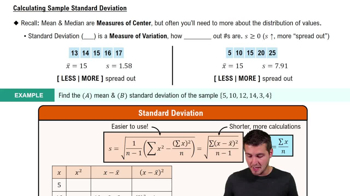Here are the essential concepts you must grasp in order to answer the question correctly.
Mean Absolute Deviation (MAD)
Mean Absolute Deviation (MAD) is a measure of the dispersion of a data set. It quantifies the average distance between each data point and the mean of the data set, providing insight into the variability of the data. The formula MAD = Σ |x − x̄| / n involves summing the absolute differences between each data point (x) and the mean (x̄), then dividing by the number of observations (n). This measure is particularly useful because it treats all deviations equally, without squaring them as in variance.
Recommended video:
Calculating Standard Deviation
Sample Standard Deviation
The sample standard deviation is a statistic that measures the amount of variation or dispersion in a sample data set. It is calculated using the formula s = √(Σ (x - x̄)² / (n - 1)), where x is each data point, x̄ is the sample mean, and n is the sample size. Unlike MAD, the standard deviation squares the deviations, which emphasizes larger differences and can be more sensitive to outliers. It is widely used in statistics to understand the spread of data points around the mean.
Recommended video:
Calculating Standard Deviation
Comparison of MAD and Standard Deviation
Comparing Mean Absolute Deviation (MAD) and sample standard deviation provides insights into the nature of data variability. While both measures indicate how spread out the data points are, MAD offers a straightforward interpretation as it uses absolute values, making it less sensitive to extreme values. In contrast, the standard deviation, by squaring the deviations, can be influenced more by outliers. Understanding these differences helps in selecting the appropriate measure of variability based on the data characteristics.
Recommended video:
Calculating Standard Deviation
 Verified step by step guidance
Verified step by step guidance Verified video answer for a similar problem:
Verified video answer for a similar problem:



 8:45m
8:45m